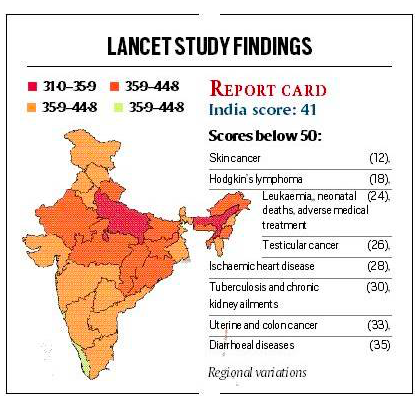Imbalance in Improvement? India ranks 145th in Global Healthcare access Index
India – The second most populated country, the 7th largest country in the world and 145th among 195 countries in healthcare, disparity among states. Just read once more and realize the difference. Yes. While India stands at the top position in many areas, while it comes to healthcare, India is in bottom 50.
A Global Burden of Disease study published in the Lancet journal states that India ranks a lowly 145th among 195 countries in terms of healthcare access and quality (2016). In the study, each country was given a health care access and quality score (HAQ) score ranging from 0 to 100. India’s HAQ score in 1990 was 24.7. Now it has risen to 41.2. For the score indexes, the study used an index based on 32 causes of death that should be preventable with effective care.

Image source: Indian Express
The study has also focused on analyzing healthcare access and quality between regions of seven countries including India. The result was, India and China had the widest disparities; 43.5 and 30.8 points, respectively. the global average is 54.4 and Iceland and Norway top the list with a HAQ score of 97. Among the 7 countries, Japan had the narrowest rate of 4.8 points. If we check the score of the states in the country, Goa and Kerala stand at the top, with the highest score of 60 above, and Assam and Uttar Pradesh being the lowest having a score below 40. It is clear that India has seen improvements from 1990. But concerning the HAQ score, India’s score was lower than 50 for 23 out of 32 causes of death. The score is particularly low for skin cancer(12), neonatal deaths and adverse medical treatment(24) and for tuberculosis and chronic kidney ailments(30).
“This is really disappointing – well behind BRICS countries. This does not surprise me since TB deaths should be rare if quality care was available. We know India accounts for nearly 30 percent of global TB death. TB is often missed by practitioners, and MDR-TB is diagnosed very late. In the public system, patients are lost along the entire care cascade, and this means only 1 in 2 TB patients make it to the finish line. With MDR-TB, only 1 in 5 patients cross the finish line and successfully complete therapy. All this makes for a poor HAQ score. The bottom line, simply focusing on coverage of TB services is not enough. We need to also improve quality of TB care, in both private and public sectors.” Dr. Madhukar Pai, Canada Research Chair in Epidemiology and Global Health said to a media.
According to Dr. K. Srinath Reddy, president of Public Health Foundation of India(PHFI), the reason for India’s poor show is the low density of health workers in the poorly performing states. As an example, he states that the Janani Suraksha Yojana has registered a rise in the number of institutional deliveries. However, there is no demonstrable correlation with lowering of maternal mortality in certain states.
So correlating the scores and the opinions, we can clearly understand how weak the health system of India is and quality has not improved in certain states despite the funded schemes providing health access from the government. So, what do all these points mean? It’s high time to make some changes in the healthcare sector and bag a top position among the countries in the world!!!
Reference: 1. Indian Express.
2. Content Measuring performance on the HealthcareAccess and Quality Index for 195 countries and territories and selected subnational locations: a systematic analysis from the Global Burden of Disease Study 2016.
-
Fullman, Nancy et al.The Lancet , Volume 0 , Issue 0 ,